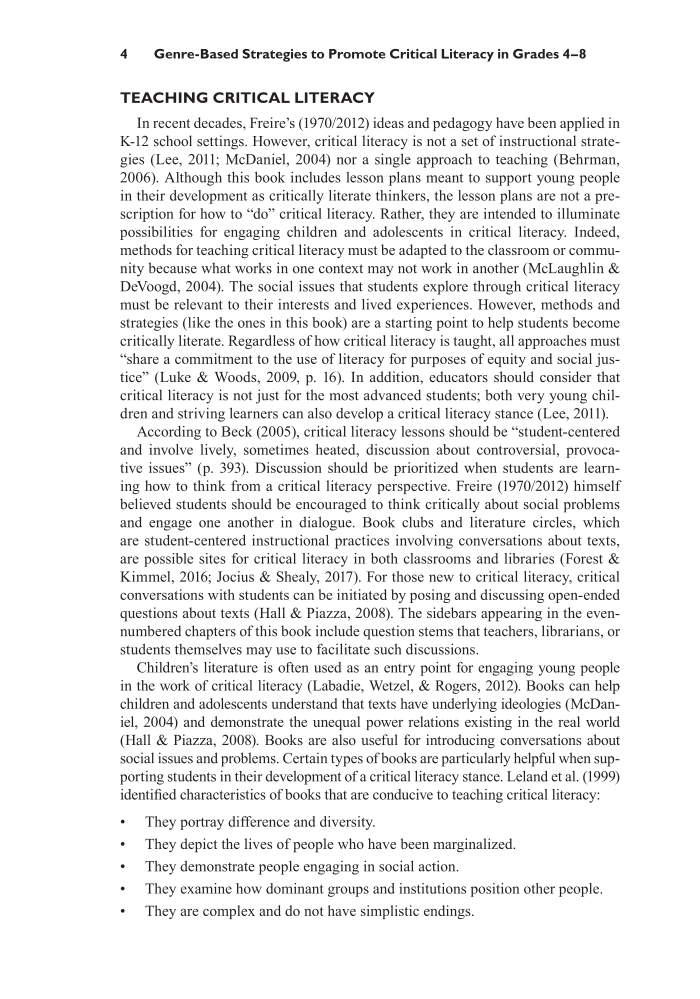4 Genre-Based Strategies to Promote Critical Literacy in Grades 4–8 TEACHING CRITICAL LITERACY In recent decades, Freire’s (1970/2012) ideas and pedagogy have been applied in K-12 school settings. However, critical literacy is not a set of instructional strate- gies (Lee, 2011 McDaniel, 2004) nor a single approach to teaching (Behrman, 2006). Although this book includes lesson plans meant to support young people in their development as critically literate thinkers, the lesson plans are not a pre- scription for how to “do” critical literacy. Rather, they are intended to illuminate possibilities for engaging children and adolescents in critical literacy. Indeed, methods for teaching critical literacy must be adapted to the classroom or commu- nity because what works in one context may not work in another (McLaughlin & DeVoogd, 2004). The social issues that students explore through critical literacy must be relevant to their interests and lived experiences. However, methods and strategies (like the ones in this book) are a starting point to help students become critically literate. Regardless of how critical literacy is taught, all approaches must “share a commitment to the use of literacy for purposes of equity and social jus- tice” (Luke & Woods, 2009, p. 16). In addition, educators should consider that critical literacy is not just for the most advanced students both very young chil- dren and striving learners can also develop a critical literacy stance (Lee, 2011). According to Beck (2005), critical literacy lessons should be “student-centered and involve lively, sometimes heated, discussion about controversial, provoca- tive issues” (p. 393). Discussion should be prioritized when students are learn- ing how to think from a critical literacy perspective. Freire (1970/2012) himself believed students should be encouraged to think critically about social problems and engage one another in dialogue. Book clubs and literature circles, which are student-centered instructional practices involving conversations about texts, are possible sites for critical literacy in both classrooms and libraries (Forest & Kimmel, 2016 Jocius & Shealy, 2017). For those new to critical literacy, critical conversations with students can be initiated by posing and discussing open-ended questions about texts (Hall & Piazza, 2008). The sidebars appearing in the even- numbered chapters of this book include question stems that teachers, librarians, or students themselves may use to facilitate such discussions. Children’s literature is often used as an entry point for engaging young people in the work of critical literacy (Labadie, Wetzel, & Rogers, 2012). Books can help children and adolescents understand that texts have underlying ideologies (McDan- iel, 2004) and demonstrate the unequal power relations existing in the real world (Hall & Piazza, 2008). Books are also useful for introducing conversations about social issues and problems. Certain types of books are particularly helpful when sup- porting students in their development of a critical literacy stance. Leland et al. (1999) identified characteristics of books that are conducive to teaching critical literacy: • They portray difference and diversity. • They depict the lives of people who have been marginalized. • They demonstrate people engaging in social action. • They examine how dominant groups and institutions position other people. • They are complex and do not have simplistic endings.
Document Details My Account Print multiple pages
Print
You have printed 0 times in the last 24 hours.
Your print count will reset on at .
You may print 0 more time(s) before then.
You may print a maximum of 0 pages at a time.




































































































































































